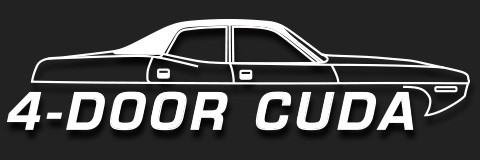After doing three OE restorations between 2005 – 2010, I decided it was time to do something different in the Automotive World. The thought came about after finding an Artist’s rendering of a light blue/gray 4 Door Cuda. After seeing that drawing in September 2010, I asked Steve Been what he thought about actually building a 4 Door similar to the rendering. Instead of doing one exactly the same, we decided to build one with a Rally Hood, Gator Grain Top, 383 CID engine and Lemon Twist Yellow in color. After discussing the possibilities, we concluded it would have to be built from an existing 4-door Chrysler platform. The closest option that would give us what was needed was a 1971-1974, 4-door Coronet or Satellite. We contacted Clay Kossuth (a Friend and Mopar aficionado) to see if he had a candidate sitting in his salvage yard. He said that he had a cut up, stripped hull of a 1972 Coronet 4 Door that might work. Accompanied by Steve Been and Tom Barcroft, I went to visit Clay. We looked at what was left of the hull and decided it would provide the basic pieces necessary to start this 4 Door Barracuda build. It had a Roof, its A Pillars and B Pillars.
From there, we researched what was needed to engineer and fabricate components for the build. Steve had been doing some computer research for ideas when he stumbled across an article written by Roger Johnson. We didn’t know who Roger was and had never spoken with him at that time. In the article, Roger described a red 4 Door Barracuda parked on a loading dock behind the Highland Park Chrysler Headquarters. This occurred sometime in early fall of 1969. After reading his commentary on this Concept vehicle, I decided to take a different direction with the Project. Instead of building the vehicle the way we originally planned, I decided to build the Car to represent the Concept that Mr. Johnson had written about. I then chose to take things one step further. What if Chrysler had actually built a 4 Door Barracuda? With that mindset, I decided to do a “What If” theme similar to the one in the movie “IT’S A WONDERFUL LIFE”.
The Project Car would now be built as if Chrysler would have taken a different direction in their marketing scheme and given a “thumbs up” in offering a 4 Door Barracuda to the public. This new course also allowed us to incorporate all of our past OE experience into this one-of-a-kind custom car. In essence, we became the Factory in the building of this unique vehicle.
The next step was to contact Roger Johnson to get his personal account of what he saw several times in the early fall of 1969. In March of 2013, Roger responded to one of my emails. I informed Roger of what we were doing and have remained in contact ever since. We’ve enjoyed many phone conversations about “back in the day” topics and other Chrysler stories. He provided us with as much information as possible concerning his encounters with the 4-door Barracuda he saw. From there, we decided to add various options to this project, since he was not able to provide details about things like the power train of the car. As a matter of fact, he said he wasn’t sure if the concept had a power train installed at all. It just looked like it was ready to drive from his 75 foot vantage point.
One important point to remember is that we never had a car to start with. All we had was a conceptual idea and vision for this project. There was no donor vehicle. Every nut, washer, hose, wire, fastener, Body component, bracket, Interior piece, etc…… had to be collected, fabricated and assembled from scratch to make this Car. From day one, our purpose was to build a 4-door Barracuda. To get this Project started, we needed a roof, A-pillars and B-pillars from a Chrysler 4-door platform. Even after finding those pieces, they still had to be cut apart and altered to accommodate our design. They no longer exhibit their original shapes or factory composition. Many of the changes that were made are drastic yet unnoticeable at a glance. We used replacement body panels that were either NOS or aftermarket pieces. Every single body panel was altered and no longer exhibits a “Factory” fit. They had to have flat metal pieces added, sections removed and alterations of some sort to provide a correct fit. Many other pieces were fabricated from flat metal stock by using Body Hammers, English Wheels and heat for shaping. Even the door hinges were altered to work with the custom doors. Not a single exterior panel will fit any other vehicle built by Chrysler. To look at the Car, no one would ever know these component changes have been made.
All exterior trim was either fabricated or altered to fit this 4 door Barracuda design. The Interior is made of custom components, specific to this build. The door panels, rear package tray, rear arm rest fillers, carpet, headliner, tilt telescopic steering column, A-pillar trim, windshield trim, etc….. are all custom, fabricated parts. There were hundreds of major alterations necessary for this project build to materialize. It took over 6 years and more than 10,000 man-hours to complete. It’s a custom car, designed and built from scratch, that looks like a factory assembled 1970 4-door Barracuda.
The main builders of this project were Steve Been and myself. From 2014-2015, Rick Bommarito was also instrumental in fabricating components for the door window openings, aligning body panels and other miscellaneous build duties.




